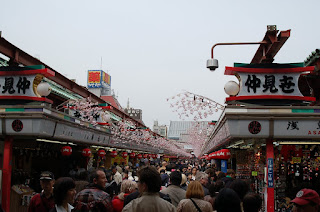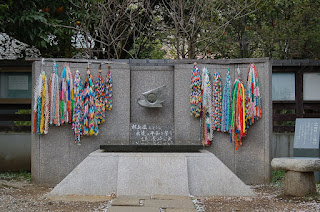We started at the Kaminarimon Gate, with a 100 kg (220 lbs) lantern hanging in the middle. (I wish we could see it lit!) It also had two statues inside representing the gods of thunder and wind, which are supposed to be ready to protect the deity in the temple beyond. They, like all other statues inside gates around Japan, were enclosed in mesh, making it difficult to get a decent picture. You can almost see them in the picture, flanking the lantern.

We strolled down the Nakamise Dori, which is a packed pedestrain street lined with souvenir and sweet shops. According to the book, record show there have been vendors here since the late 17th century, so I guess this really is the historical side of Tokyo!

We walked through all the people and peeped in a few shops, passed a five story pagoda to reach the real highlight of this walking tour. At the end of Nakamise Dori is Sensoji Temple, the oldest in Tokyo. After passing through another gate (Hozomon), we see that the temple is completely enclosed. Apparently they are doing some long term work on it. Very disappointing. We went inside and the shrine was very pretty, although it was surrounded by mesh as well, which doesn't allow for good photos. The ceiling was beautifully painted, but as the light was dim inside it also did not photograph well.
 Hozomon Gate with the temple incense burner; people are 'washing' themselves in the smoke to purify themselves.
Hozomon Gate with the temple incense burner; people are 'washing' themselves in the smoke to purify themselves. 
Inside Sensoji Temple.
There was a very small, picturesque garden with some shrines next to the temple that was also very lovely. And that was the end of our Asakusa walking tour. As I had expected this to take a few hours longer, this was wonderful news because it meant we could see more! So we plotted a course for Ueno Park, full of things to do and see. I wanted to go to the zoo here because it was supposed to have a giant panda, one of the few zoos in the world to possess one. When we got to the zoo there were several signs that said "We DO NOT have a giant panda." (She died two years ago.) I was very disappointed, again. But we had to go because the girls knew we were at the zoo and were clamoring to go in. Tip: if in Tokyo do not waste your time here! It's a very small zoo and when we were there most of the animals weren't even out because they were cleaning their pens. (Aren't they supposed to do that when they don't have paying customers?) I had to content myself with a mediocre view of a red panda and a picture with a plastic giant panda.

After our visit to the zoo was over, we strolled around Ueno Park some more. It's a very big park. We came across what I now know is the Toshogu Shrine, erected in 1651 in honor of Tokugawa Ieyasu, the man who made Edo (Tokyo) the seat of government, thus setting in motion its history. The shrine itself was closed when we were there, which is a pity; it has cool stuff inside! But we did walk along the copper lantern lined path. There are 50 lanterns, each donated by daimyo (feudal lords) from around Japan.

In this area there was also a Hiroshima memorial. There is a flame burning on it that is supposed to have been taken from the ashes of Hiroshima and kept burning ever since. In the beginning it was kept as a symbol of the desire for revenge, now it is meant to represent the desire for peace. In Japan they make paper chains to place instead of using flowers. You can see these hanging on the sides.

We didn't have time to go to the peace memorial in Hiroshima, though I really wanted too. It seems almost sacrilegious in a way to be American and not go pay your respects at Hiroshima!
After this we got on a paddle boat and went around the lake, admiring the cherry blossoms some more and laughing at a cat. I don't want to say we were laughing at the people who owned the cat, but this cat (fur covered I assume) was dressed in a baby parka, had a stroller, and was being hand fed. They were taking pictures of the cat with the blossoms. (Americans are not the only people obsessed with their pets.) I don't know, maybe it was a show winning cat?

Next stop was dinner and the hotel, but first I couldn't resist the free observation tower so close to our hotel! Tokyo really is a big city!

And that's the end! We did spend one more day in Tokyo, but it was dedicated to DisneySea. We chose DisneySea because it is unique to Japan. I'm glad we went, but it's kind of a rip off. There are very few rides and shows; it's mostly souvenir shops and restaraunts, and they don't use the FastPass system adequately. I was disappointed, but the girls had a blast and that is why we went.


 our room; see the futons?
our room; see the futons? It's pretty cool to steam and snow in the same place! I thought at first it may be a hot springs hot spot, but no. These are sulfur vents, though there are some hot springs around. You can buy and consume eggs boiled in the sulfur water (the shells turn black) which are supposed to add longevity to your life; eating more than 2 1/2 is taboo. We didn't do this. You had to hike out a little way too it and we chose to be happy with our photos and continue on.
It's pretty cool to steam and snow in the same place! I thought at first it may be a hot springs hot spot, but no. These are sulfur vents, though there are some hot springs around. You can buy and consume eggs boiled in the sulfur water (the shells turn black) which are supposed to add longevity to your life; eating more than 2 1/2 is taboo. We didn't do this. You had to hike out a little way too it and we chose to be happy with our photos and continue on. You can clearly see the sulfur, and it does indeed smell like rotten eggs!
You can clearly see the sulfur, and it does indeed smell like rotten eggs! Lake Ashi
Lake Ashi

 Not much to say about this place either. I believe it's mostly a tourist resort area. We were hoping to get a better view of Fuji here since our first view of Fuji was obscure at best.
Not much to say about this place either. I believe it's mostly a tourist resort area. We were hoping to get a better view of Fuji here since our first view of Fuji was obscure at best. That bright white spot in the center is all of Fuji San we got to see. They say that winter is the best time to see it, when the skies are clearer, but I don't know that I 'd want to stay here in winter; April was pretty chilly!
That bright white spot in the center is all of Fuji San we got to see. They say that winter is the best time to see it, when the skies are clearer, but I don't know that I 'd want to stay here in winter; April was pretty chilly!










 This is the Ote-mon Gate with earthen walls. It is the original gate from 1628, with much restoration of course. If you look closely you can see small holes near the top of the earthen walls. As you can guess these were used for defense purposes.
This is the Ote-mon Gate with earthen walls. It is the original gate from 1628, with much restoration of course. If you look closely you can see small holes near the top of the earthen walls. As you can guess these were used for defense purposes. 







 This is Nan' en-do, originally built in 813 with the present structure dating from 1741. It is also part of the Kofukuji complex.
This is Nan' en-do, originally built in 813 with the present structure dating from 1741. It is also part of the Kofukuji complex.



 If you look closely toward the right of the picture, in the center, you can see a pagoda, Toji Pagoda. It is the tallest in Japan. Stretching to the left is the Buddhist complex of Toji.
If you look closely toward the right of the picture, in the center, you can see a pagoda, Toji Pagoda. It is the tallest in Japan. Stretching to the left is the Buddhist complex of Toji.

